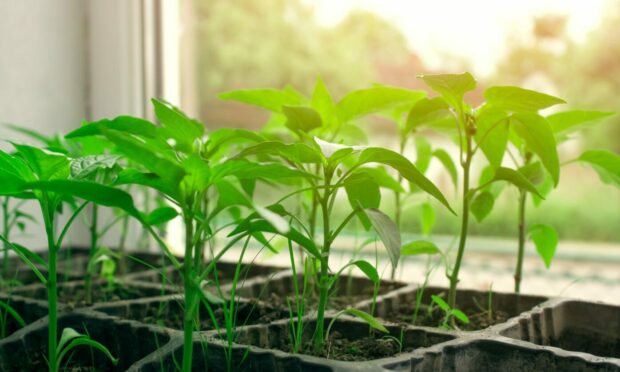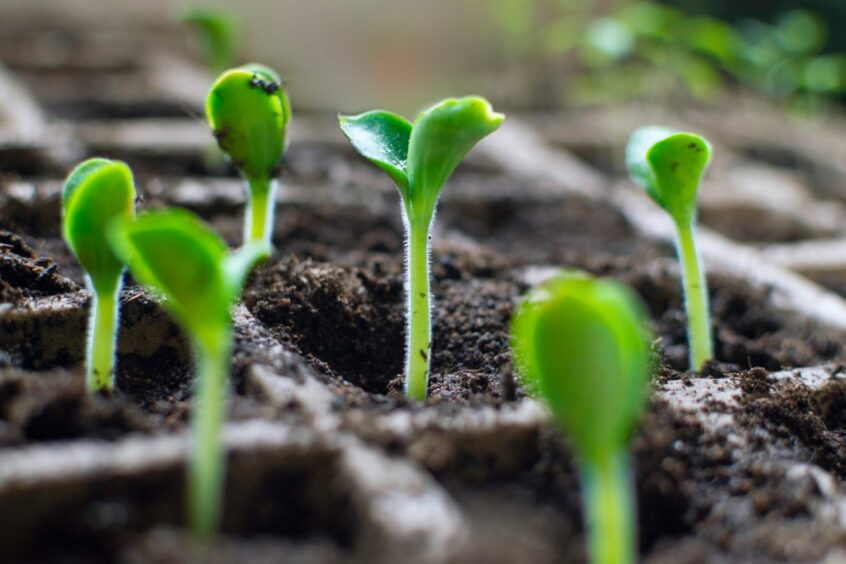It’s felt like a long wait but at last I’m enjoying one of my favourite sights in the glasshouse – trays of chitting potatoes.
It makes me happy as it means we’re starting to see some real springtime action in the garden and the proper start to the growing season.
‘Chitting’ is one of those tricks us gardeners use to extend the growing season.
Indoor advantages
With the weather being so unpredictable at this time of year, we can take advantage of our windowsills, glasshouses, porches and conservatories to start growing plants earlier than if we only had the outdoors to play with.
As well as our prized ‘tatties’ we can also do this with other vegetables – lettuces and leeks, cabbages, cucumbers and juicy tomatoes.
Scotland’s winters typically involve a lot of wet weather or can be cold and frosty. Most years it’s both, but neither a seed potato or indeed any of our veg seed like this.
We can buy ourselves a bit of extra growing time indoors, until the soil is ready.
To ‘chit’ potatoes simply involves placing the tubers in seed trays or if you don’t have a stash of these then keep a hold of your egg boxes and use them.
Look out for the ‘eyes’, they are like little clusters of growth and is from where the shoots are going to grow, place them pointing upwards and towards the light.
Extra protection
We want to avoid too much light so I cover my trays with a newspaper to filter the strength of sunlight coming through.
If we get the conditions correct then once the young shoots have reached about 2cm/ 1in then the potatoes will have reached the perfect stage for planting which will coincide with the weather conditions being more suitable for planting out.
Without the newspaper there’s a tendency the young shoots will grow becoming drawn and stretched, they won’t have the strength they should have to hold themselves up and could get easily damaged.
This is one of the reasons that, in a few weeks time as the sun gets higher in the sky and the light gets stronger, we should apply a layer of white, cool glass over the panes of our greenhouses. Or as I do, attach green shade netting to the inside.
Of course when we do this and can plant our potatoes or sow our first seeds outdoors will also depend on the weather.
The return of Beechgrove Garden to our television screens is only a weeks away. It wouldn’t be the first time that the presenters on the opening programme are all revelling in the spring sunshine only to be dressed in snow gear a few episodes later!
The simplest indicator for me that the soil in our gardens is ready for sowing or planting is when you start to see weeds growing.
If the seeds of those are germinating, that’s when you’ll know the soil is warm enough for the plants we really want to see growing.
That certainly beats the method I’ve heard of in gardening circles of baring your bottom and sitting on the soil. If you manage to ‘bare it’ (sorry) for more than a split second then apparently that means you’re good to go.
What the soil says
I think I’ll keep putting up with a few weeds or follow the guide books using a soil thermometer, springing in to action after a good few days of the soil temperature being above 7 degrees centigrade.
If we want to grow tasty, healthy vegetable crops we need to be growing them in clean and healthy soil. Therefore we must replenish it with goodness annually to help replace all the nutrients used up growing last year’s crops.
I follow the no-dig method of growing vegetables and to do this, I apply a covering of organic matter on top of the soil a few inches/ around 10cm thick of either home-made compost, farmyard manure, bags of shop bought compost, leaf mould or, in most years, a concoction of all the mentioned mixed.
This adds fresh life to the soil, benefitting the good bacteria and insects already within it. In particular the worms that will come up to the surface for a feed, bringing it down through the layers to where the roots will be this year’s plants, creating channels that will improve drainage in the process.
I’ve been growing my veg this way for a few years now and I’m getting good results.
I’m also achieving this without using any fertilisers, that is the granules and the powders that undoubtably give great short and sharp boosts but don’t provide any long term benefits to your soil.
The great thing about trying to start off your vegetables early is if you succeed, fantastic, you’ll be munching on some fresh homegrown salad in a matter of weeks.
And if you fail, we’ll there’s nothing to worry about as there’s still going to plenty of time to get started, as spring progresses and the temperatures rise.
Veg plot or containers, window sill or glasshouse, I urge you to give growing your own a go this year. Not only is it good for you, it’s great fun.




Conversation